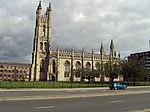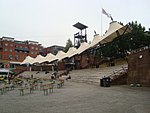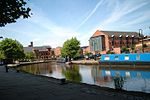Hulme Locks Branch Canal
1838 establishments in EnglandCanals in ManchesterCanals opened in 1838Harv and Sfn no-target errorsUse British English from May 2017

The Hulme Locks Branch Canal is a canal in the city of Manchester. It is 200m (one furlong) in length and was built to provide a direct waterway between the Mersey and Irwell Navigation and the Bridgewater Canal. The canal opened in 1838 and was superseded in 1995 by a new lock at Pomona Dock 3. As both of its locks remain closed, the canal is now overgrown.
Excerpt from the Wikipedia article Hulme Locks Branch Canal (License: CC BY-SA 3.0, Authors, Images).Hulme Locks Branch Canal
Quenby Street, Manchester Hulme
Geographical coordinates (GPS) Address Nearby Places Show on map
Geographical coordinates (GPS)
| Latitude | Longitude |
|---|---|
| N 53.47 ° | E -2.26 ° |
Address
Quenby Street
M15 4HW Manchester, Hulme
England, United Kingdom
Open on Google Maps









